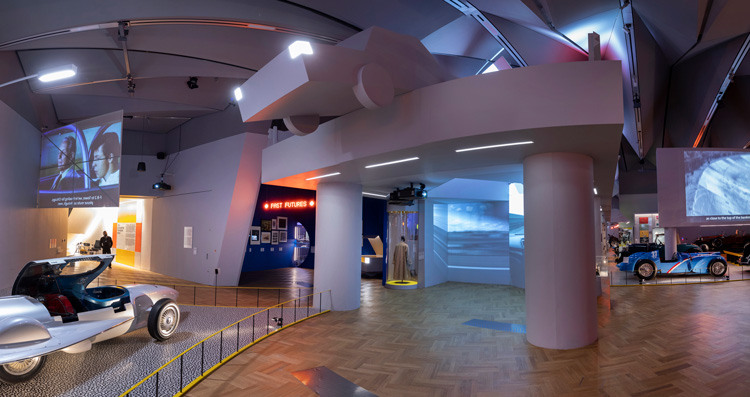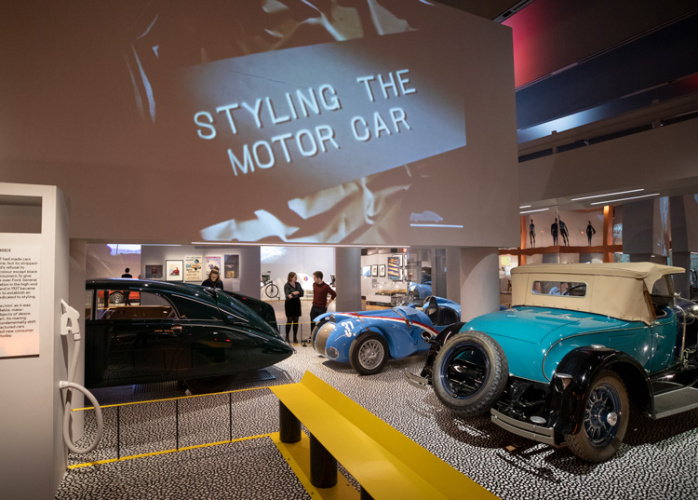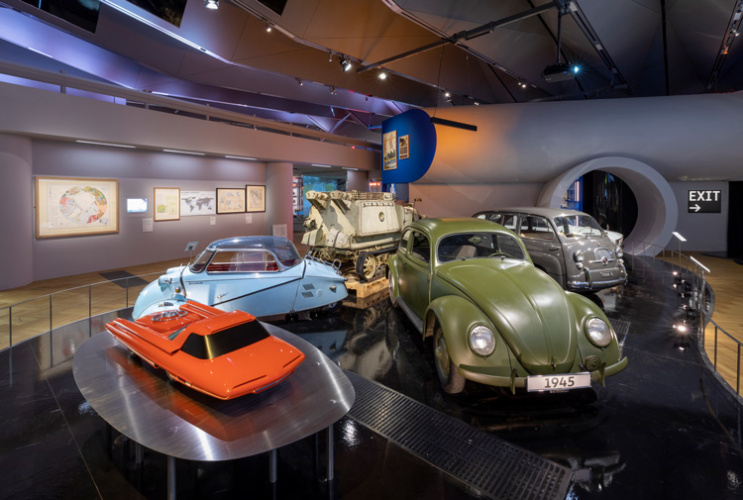V&A’s blockbuster exhibition “unpicks the history of the car as a design object”
Cars: Accelerating the Modern World — the first exhibition exclusively dedicated to automobiles at the museum — explores the machine’s history and future.
An exhibition about cars present problems, in terms of design and curation. How do you display a machine known for its speed and movement within museum walls? How do you avoid it looking like a car showroom? And how do you balance the image of the car — as a major contributor to the climate crisis — against its undeniable use to society?
The V&A’s latest exhibition attempts to bring these wide-ranging themes together, and for the first time. Although it has featured cars in exhibitions before, Cars: Accelerating the Modern World is the museum’s first exhibition dedicated to the automobile.

The exhibition is split into three sections that explore the car’s history, from the start of the 18th century to present day. ‘Going Fast’ explores how cars’ speed gave drivers a new sense control and modernised life. The following section, ‘Making More’, looks at mass production with a focus on the Ford production plant in Detroit. The final section, ‘Shaping Space’, examines the impact of cars on the world, and in particular the effects of the combustion engine on the environment. All the sections are signposted by variable message signs which hang overhead, contributing to the all-encompassing motoring theme.

The exhibition has a wide scope, showcasing 15 cars and 250 objects. Among some of the vehicles are the 1888 Patent-Motorwagen No.3 by Karl Benz, the first production automobile ever made. From 1934 is the Tatra T77 from engineers Hans Ledwinka and Paul Jaray, the first ever mass-produced car. There’s also the Firebird 1 from General Motors — this 1953 model was one of four concept cars that was inspired by the period’s aircraft fighters.
Each section also aims to show how the automobile has affected other mediums such as architecture, fashion and even music videos.
“There’s no moralising about the car”
The exhibition has been designed by London-based OMMX. The design studio’s director, Jon Lopez says: “You’ve got a room full of cars, and we wanted to create the visceral thrill of driving and speed, wonder and thrill of movement.”
At the same time, OMMX didn’t want to “fetishize” the machines as if in a car show room. “There’s no moralizing about our idea of a car — the exhibition’s trying to find a balance between the positives and negatives,” Lopez adds.

One of the most striking aspects of the exhibition is its set design. Lopez says that the studio wanted to create a “world within a world”. This resulted in a model city, including a bus stop, a display based on the Detroit Ford factory and a billboard. The centrepiece is a life-size highway structure that bisects the main hall, which creates an exciting, almost-dizzying feel for visitors.
To give the design a sense of coherence and “model-like quality” — as if mimicking an actual car — these structures are all made from the same material, a grey-painted MDF.
A floor-to-ceiling display case — painted the shade of the orange Ford Mustang which is on show nearby — stands on one side of the exhibition space.

“We were interested in taking a series of objects to show how cars have affected the built environment,” Lopez says. “It almost bypasses you how much the car has shaped the DNA of our environment.”
Another way to add “dynamism” and “changes in tempo” was by creating an audio-visual heavy show. At the beginning of the exhibition, a timelapse video filmed from a driver’s seat is projected onto the highway structure, giving the exhibition an urgent start.

Visual cues are particularly important in creating atmosphere: the exhibition features lighting that mimics street lamps as well as the lights that car manufacturers use to check for imperfections and blemishes.“We’re trying to think of all the way that cars are lit during production, but also externally in their natural habitat, so to speak,” Lopez says.
Lights also pass above the roof of the exhibition, which “give a sense of vehicular movement above the room,” he adds.
“Look how absurd this is”
Underpinning the exhibition design is a “sense of humour”, Lopez says. The reference point was not a film that glamorises cars or racing but instead French filmmaker Jacques Tati’s PlayTime, which explores the “absurdist nature of technology and how we are meant to deal with it.”
Lopez says that they were inspired by one image in particular: cars crowding a roundabout and beeping at one another. This “strange figuration” highlights cars’ “uncomfortable relationship to one another”, he adds.
Lopez says: “Instead of saying ‘Look at how fast this car can do, ‘this exhibition is more like: ‘Look at how absurd this situation is.’”

Surprising objects add to this sense of humour. In ‘Going Fast’, there are designs from the Bauhaus movement, as well as a model house from Le Corbusier to show how car production affected different mediums. There’s also a Motown music video — Nowhere to Run by Martha and the Vandellas — playing, which was filmed inside a car manufacturing factory.
“The objects show how car production took over the popular imagination,” Brendan Cormier, the exhibition’s curator, says. “We wanted to unpick the history of the car as a design object.”

Among the 15 cars on display is the Pop-Up Next flying car, designed by Italdesign with Airbus and Audi. According to Cormier, it combines four the themes of mobility’ future: autonomous driving, electric vehicles, service-oriented designs (users will order it through an app) and flying. It is the first time the car has been displayed in the UK.
The flying car is surrounded by a 180-degree film installation which shows the history of the car from its “original promises” to its “unintended consequences”. Cormier hopes that the combination of the flying car with this retrospective will show how “we’ve come full circle” — highlighted by the beginning of the exhibition, which displays past concepts for future cars.
“Like all cycles, there is a problem, a solution, then a new problem, then a new solution,” Cormier says. “There will never be a definitive conclusion to the question of mobility.”
A balanced view
Though innovation in car design seems imminent, it is also a contentious time for the machine: its damaging effect on the environment and contribution to the climate crisis is clear. This delicate balance is explored throughout the exhibition.
Three screens have been installed; the first counts the number of traffic deaths this year as a way to highlight the impact of cars’ speed in human terms, the second shows the number of automobiles that are being produced in real time, and the final counts the diminishing barrels of oil left in the ground.

There’s also a visualisation of global heating that tracks heat records over 100 years in the penultimate room. In this area, black vinyl also lines the floor in a way that might remind visitors of an oil slick. These more sombre design details balance the excitable tone of the exhibition.

Cormier says that these features “grapple with the contradictions” involved in the car’s history. It might make visitors thing about humankind’s love affair — and reliance — on the automobile.
Cormier sees this as a necessary route to finding a solution. “We can’t deny the human attractions to cars, and any rational response to the car has to embrace both aspects,” he says. “We need to understand why a billion cars have come to be on the road before we can think of alternatives.”
Cars: Accelerating the Modern World runs from 23 November 2019 – 19 April 2020 at the V&A, Cromwell Road, Knightsbridge, London SW7 2RL. Tickets cost £18.
-
Post a comment





